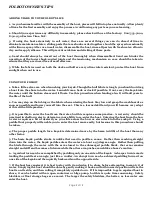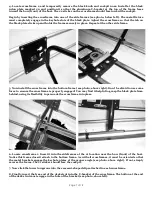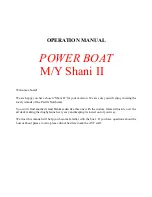
Page 3 of 12
FOLBOT OWNER’S TIPS
ADDING YEARS TO YOUR FOLBOT’S LIFE
1. As you become familiar with the assembly of the boat, pieces will fall into place naturally. Allow plenty
of time for the first assembly and enjoy the process. Avoid forcing any parts as you are learning.
2. Should you experience any difficulty in assembly, please check with us at the factory: 800/533-5099,
8:30-4:30 Eastern Time, M-F.
3. If using the boat extensively in salt water, there are several things you can do ahead of time to
eliminate maintenance later: sliding parts that are shock-corded together should be sprayed occasionally
with silicone spray. After use in salt water, disassemble the boat, rinse all parts with fresh water, allow to
dry, and reapply silicone. This will prevent oxidation and sticking of these parts.
4. Sand should always be rinsed out of the boat thoroughly when disassembled. Sand can hinder the
operation of the lower shock-corded joints and the tensioning mechanism, so care should be taken to
ensure that they are rinsed free of sand after use.
5. While the fabrics used on both the deck and hull are very ultra-violet resistant, protect the boat from
sunlight when not in use.
USING YOUR FOLBOT
1. Take a little extra care when launching your kayak. Though the hull fabric is tough, you should not drag
a boat from the shore into the water. Launch from a bank or dock if possible. If not, carry the kayak into
the water until the bottom clears and it floats. Use this procedure when landing also. It will add years to
the life of the hull.
2. You may step on the tubing or the fabric when entering the boat. Stay low and grasp the washboards as
soon as possible and lower yourself into the seat. This is a learned skill and you will become very adept
at this with a little practice.
3. It is possible to enter the boat from the water, but this requires some practice. A wet entry should be
practiced in shallow water to determine your ability to re-enter the boat. Entering the boat from the bow
or stern requires a bit of dexterity as you slide across the bow or stern deck into the cockpit. Using a
paddle float properly will enable you to enter the boat more easily, but lessons in this procedure should
be taken.
4. The proper paddle length for a kayak is determined more by the beam (width) of the boat than any
other factor.
5. The basic kayak paddle stroke is unlike that used to paddle a canoe. Rather than reaching straight
down into the water, the kayak paddle enters the water at about a 45-degree angle. Rather than pulling
the blade through the water with the arm closest to the submerged paddle blade, that arm remains
straight and stiff and becomes a fulcrum while the other arm pushes, much like a boxer’s motion.
6. A gradual turn can be accomplished by paddling only on one side of the kayak. A sharper turn is made
trailing the paddle at an angle, just like a rudder. An abrupt turn can be achieved paddling forward on
one side of the kayak and then quickly backwards on the opposite side.
7. If the boat has capsized, it is best to stay with it and swim it to shore before attempting to empty it of
water. Emptying the boat should be done by gently rocking it back and forth toward a position where the
boat is on its side, and then rolling it completely upside down. If it is impossible to get a capsized boat to
shore, it can be bailed with an open container or bilge pump, but this is quite time consuming. Safety
bladders or float storage bags are a must. The larger the safety bladders, the better, as less water can
enter the boat.
Summary of Contents for GREENLAND II
Page 1: ...GREENLAND II OWNER S GUIDE www folbot com...
Page 2: ...Page 2 of 12...
Page 11: ...Page 11 of 12 NOTES...
Page 12: ...Page 12 of 12...






























